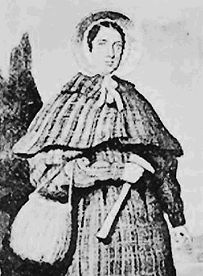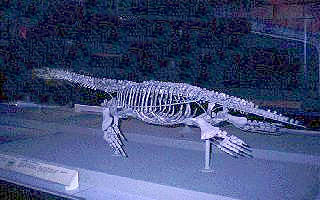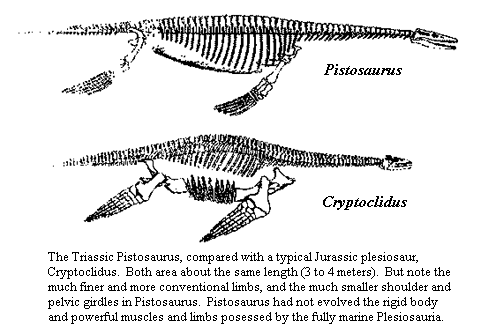
| Palaeos |  |
Sauropterygia |
| Vertebrates | Plesiosauria |
| Page Back | Unit Home | Unit Dendrogram | Unit References | Taxon Index | Page Next |
| Unit Back | Vertebrates Home | Vertebrate Dendrograms | Vertebrate References | Glossary | Unit Next |
|
Abbreviated Dendrogram
DIAPSIDA |--ARCHOSAUROMORPHA | LEPIDOSAUROMORPHA |--SAUROPTERYGIA | |--Placodontia | |--Pachypleurosauridae | `--+--Nothosauridae | `--+--Corosaurus | `--+--Pistosaurus | `--Plesiosauria | |--Pliosauroidea | `--Plesiosauroidea | |--Elasmosauridae | `--Cryptocleidoidea `--Lepidosauriformes |--SPHENODONTIA `--SQUAMATA |
Contents
Overview |

Macroplata, in the figure at right, was a fairly typical Early Jurassic plesiosaur. The Plesiosauria (the name means "near lizards,") were an important order of Mesozoic marine reptiles, members of the superorder Sauropterygia. The Plesiosauria include both short and long-necked forms. The largest short-necked forms reached enormous sizes (lengths of over 10 meters, weight of 20 tonnes or more), while some of the later long-necked forms, although only marginally longer and not as heavily built, developed the greatest number of neck vertebrae of any animal. Plesiosaurs evolved from animals related to pachypleurosaurs and nothosaurs during the Middle Triassic. They remained somewhat rare until the end of that period, when they underwent an amazing evolutionary radiation. These reptiles then dominated the seas throughout the Jurassic and Cretaceous periods, continuing to flourish right up until the end of the Mesozoic Era.
 Plesiosaurs
were among the earliest large prehistoric creatures to be described.
Victorian British accounts are full of references to "antediluvian
monsters". Most plesiosaur material was found and described in
the Nineteenth Century, much of it located and prepared by an early
paleontologist named Mary
Anning (1799-1847). A life-long resident of Lyme Regis, England, Anning made a remarkable series of important discoveries in the Early
Jurassic seaside cliffs and limestone
quarries within walking distance of her home. Collectors quickly depleted
these coastal exposures. Sadly, by about 1910 most limestone quarries had
become mechanized, this severely limiting the collection of fossil material
before it was destroyed. After this date very little new material
was found, and paleontologists in this region were limited to re-classifying, redescribing, and reviewing old material.
Plesiosaurs
were among the earliest large prehistoric creatures to be described.
Victorian British accounts are full of references to "antediluvian
monsters". Most plesiosaur material was found and described in
the Nineteenth Century, much of it located and prepared by an early
paleontologist named Mary
Anning (1799-1847). A life-long resident of Lyme Regis, England, Anning made a remarkable series of important discoveries in the Early
Jurassic seaside cliffs and limestone
quarries within walking distance of her home. Collectors quickly depleted
these coastal exposures. Sadly, by about 1910 most limestone quarries had
become mechanized, this severely limiting the collection of fossil material
before it was destroyed. After this date very little new material
was found, and paleontologists in this region were limited to re-classifying, redescribing, and reviewing old material. Meanwhile, important discoveries were being made in North America, where sediments from the Late Cretaceous inland sea contain the remains of many large marine reptiles, including both long and short-necked plesiosaurs. This historical accident has led to the belief that plesiosaurs evolved and flourished in Europe during the Jurassic, and became rare there in the Cretaceous, spreading at that time to North America, and finally attaining world-wide distribution at the end of the period.
This opinion could not be more false. As with all large, ocean-going animals, there is no doubt that plesiosaurs had world-wide distribution virtually from the very start, even as early as the Triassic. Certainly Early Jurassic plesiosaurs are known from China, South America, and Australia as well as Europe. As with so much of paleobiology, it is misleading to make sweeping assumptions on the basis of patchy and incomplete geological preservation. MAK
 Plesiosauria:
plesiosaurs > nothosaurs.
Plesiosauria:
plesiosaurs > nothosaurs.
Range: Middle Triassic to Late Cretaceous
Phylogeny: depending on which cladistic node one wants to identify as Plesiosauria there is a choice of Eusauropterygia :Nothosauridae + * : Corosaurus + (Pistosaurus + (Pliosauroidea + Plesiosauroidea)) [HCW08] - for the stem-base definition (Nothosaurus <n; Plesiosaurus)
or Eusauropterygia
: Nothosauridae + (Corosaurus + (Pistosaurus
+ * : Pliosauroidea + Plesiosauroidea for the node-base definition (common ancestor of Pliosaurus brachydeirus and Plesiosaurus dolichodeirus (or substitute preferred crown group taxa, this is just for the sake of example) and all their descendents). Both definitions are equally valid. Of course, this is nothing next to the problem of defining tetrapoda! MAK111103
Characters: Up to 13m; nostrils high, just preorbital; $ nasals
absent; large eyes located on sides
of head; palate less specialized than nothosaurs; palate consists
mainly of vomers, large palatines & pterygoids; ectopterygoid extends to
cheek & secures palate [CG85]; interpterygoid
vacuities retained, sharp, jagged teeth set in sockets at the edge
of the jaw; heavy, rigid trunks; $ presence of nutritive foramina
in vertebral centra, on underside of cervical and caudal, on sides of dorsal
centra, and on base of neural canal (either tubes joining neural canal to
underside of spinal column, or openings into a space filled with some specialized
tissue within the body of the centrum); single-headed ribs; $ relatively short tail;
$ gastralia present and well-developed (ballast?); $ both girdles elaborated ventrally, with
massive ventral plates; space between girdles filled with thick gastralia, giving them almost continuous ventral bone surface;
anterior and posterior  limbs similar, $ hyperphalangy; $ illium
does not contact pubis; presumed rowing or "flying" locomotion; propulsive stroke, but no dorsoventral control?
limbs similar, $ hyperphalangy; $ illium
does not contact pubis; presumed rowing or "flying" locomotion; propulsive stroke, but no dorsoventral control?
Notes: There is still a school of thought that plesiosaurs laid eggs on land.
Image: (right) Plesiosaurus in the British Museum, modified from the former Donald Nute's Dinosaur Gallery site (former page), by permission.
Links: Plesiosauria Translation and Pronunciation Guide Introduction; Plesiosaur Skeleton; Marine Reptiles (NOT Dinosaurs); Plesiosaurs- Enchanted Learning Software; plesiosaurs; The UnMuseum - Sea Reptiles; List of fossils; Marine Reptiles II: Plesiosaurs - Suite101.com; PLESIOSAURIA; Untitled Document; plesiosauria (excellent, but rather incomplete site); Plesiosauria after O'Keefe, 2001 (Mikko's Phylogeny); The Plesiosaur Site (Best on the Web -- Richard has finally fixed up this site so that it really works, and the result is a very complete database); Nathis Fauna Reptilelen Mariene Reptielen; The CDM's Earth Sciences Resource Site- Elasmosauridae; Fauna (detailed image of vertebrae); The Journal of Vertebrate Paleontology (abstract).
References: Carroll & Gaskill (1985) [CG85]; Holmes et al. (2008) [HCW08]. ATW061217, rev'd ATW080330.
| Page Back | Unit Home | Page Top | Page Next |
checked ATW050109, revised ATW080330, MAK111103
Using this material. All material by ATW is public domain and may be freely used in any way (also any material jointly written by ATW and MAK). All material by MAK is licensed Creative Commons Attribution License Version 3.0, and may be freely used provided acknowedgement is given. All Wikipedia material is either Gnu Open Source or Creative Commons (see original Wikipedia page for details). Other graphics are copyright their respective owners